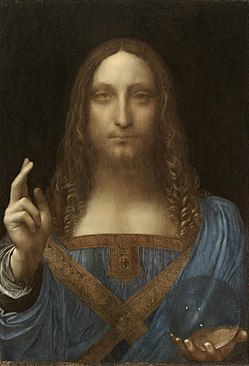Art
L’Atelier des Lumières – Site officiel – Créé par Culturespaces
Primavera (Botticelli)

Favorite Titles | MetPublications | The Metropolitan Museum of Art
Raphael – Madonna in the Meadow – Google Art Project – Madonna del Prato (Raphael)
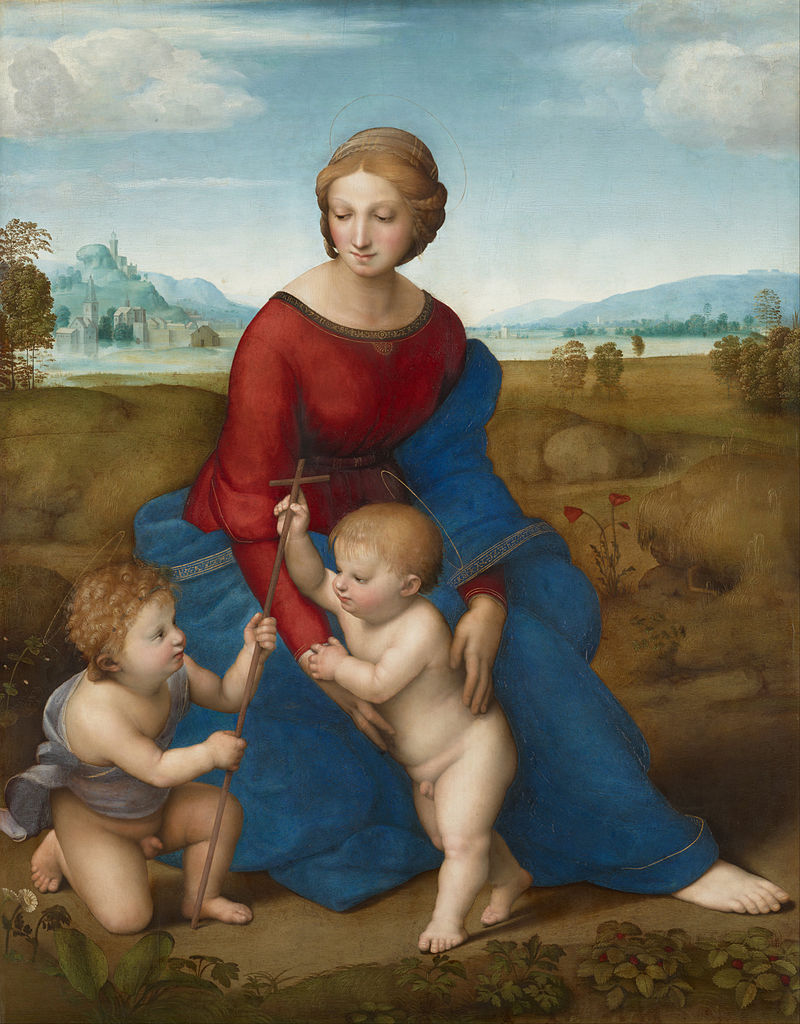
The Madonna del Prato (Madonna of the Meadow), formally Madonna with the Christ Child and Saint John the Baptist, is a 1506 painting by Raphael, now held in the Kunsthistorisches Museum in Vienna. It is also known as the Madonna del Belvedere after its long residence in the imperial collection in the Vienna Belvedere.
The figures of the Virgin Mary, the infant Jesus, and an infant John the Baptist are shown in a calm grassy meadow, linked by looks. Mary is wearing a gold-bordered blue mantle set against a red dress, extending her right leg along a diagonal. The blue symbolizes the church and the red Christ’s death, with the Madonna touching hands with Jesus the uniting of Mother Church with Christ’s sacrifice. Her eyes fixed on Christ, her head turned to the left and slightly inclined, and her hands steady him as he leans forward unsteadily to touch the miniature cross held by John. The poppy refers to Christ’s passion, death and resurrection.
Source: Raphael – Madonna in the Meadow – Google Art Project – Madonna del Prato (Raphael) – Wikipedia
Cangiante
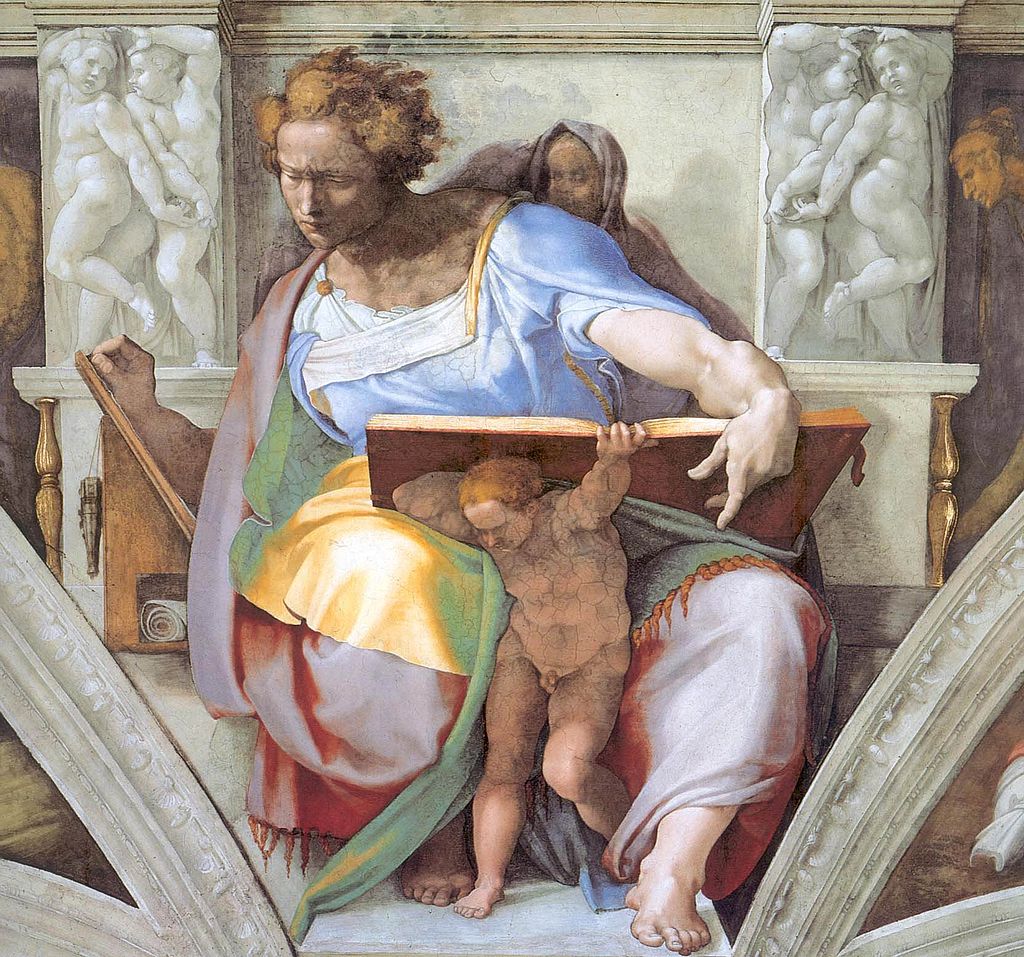
According to the theory of the art historian Marcia B. Hall, which has gained considerable acceptance, cangiante is one of four modes of painting colours available to Italian High Renaissance painters, along with sfumato, chiaroscuro and unione.[3] The word itself derives from the Italian cangiare (“to change”).
Cangiante is characterized by a change in color necessitated by an original color’s darkness or lightness limitation. For example, when painting shadows on a yellow object, the artist may use a red color simply because the yellow paint cannot be made dark enough. There are other methods of rendering shadows or highlights (for example, mixing the original hue with black or brown), but these can render the shadow color dull and impure. During the Renaissance, the variety and availability of paint colors were severely limited.
An early example of cangiante by Giotto from the Arena Chapel. Note the shift in color on the robes.
The greatest practitioner of the cangiante technique was Michelangelo,[4] especially in many parts of the Sistine Chapel ceiling. For example, in the image of the prophet Daniel, a transition from green to yellow is evident in the subject’s robes. After Michelangelo’s time, the technique found widespread acceptance and is now a standard painting technique.
Source: Cangiante – Wikipedia
Sfumato
Sfumato (Italian: [sfuˈmaːto], English: /sfuːˈmɑːtoʊ/) is a painting technique for softening the transition between colours, mimicking an area beyond what the human eye is focusing on, or the out-of-focus plane. Leonardo da Vinci was the most prominent practitioner of sfumato, based on his research in optics and human vision, and his experimentation with the camera obscura. He used it in many works, including the Virgin of the Rocks and in his famous painting of the Mona Lisa. He described sfumato as “without lines or borders, in the manner of smoke or beyond the focus plane”.
According to the theory of the art historian Marcia B. Hall, which has gained considerable acceptance,[3] sfumato is one of four modes of painting colours available to Italian High Renaissance painters, along with cangiante, chiaroscuro and unione.
Source: Sfumato – Wikipedia
The Battle of Anghiari (painting)
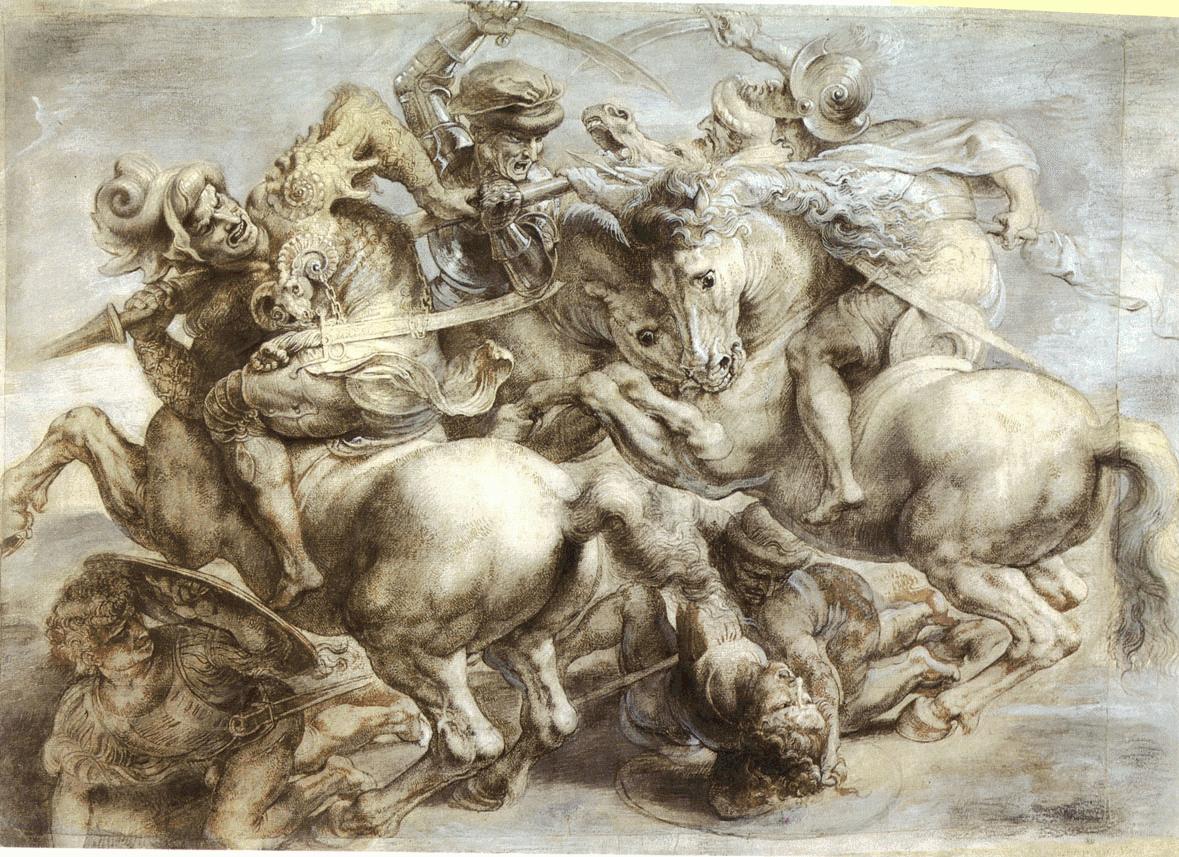
The Battle of Anghiari (1505) is a lost painting by Leonardo da Vinci, at times referred to as “The Lost Leonardo”, which some commentators believe to be still hidden beneath one of the later frescoes in the Salone dei Cinquecento (Hall of the Five Hundred) in the Palazzo Vecchio, Florence. Its central scene depicted four men riding raging war horses engaged in a battle for possession of a standard, at the Battle of Anghiari in 1440.
Many preparatory studies by Leonardo still exist. The composition of the central section is best known through a drawing by Peter Paul Rubens in the Louvre, Paris. This work, dating from 1603 and known as The Battle of the Standard, was based on an engraving of 1553 by Lorenzo Zacchia, which was taken from the painting itself or possibly derived from a cartoon by Leonardo. Rubens succeeded in portraying the fury, the intense emotions and the sense of power that were presumably present in the original painting. Similarities have been noted between this Battle of Anghiari and the Hippopotamus Hunt painted by Rubens in 1616.
In March 2012, it was announced that a team led by Maurizio Seracini has found evidence that the painting still exists on a hidden inner wall behind a cavity, underneath a section of Vasari’s fresco in the chamber.[1] The search was discontinued in September 2012, without any further progress having been made, due to conflict among the involved parties.
Peter Paul Rubens
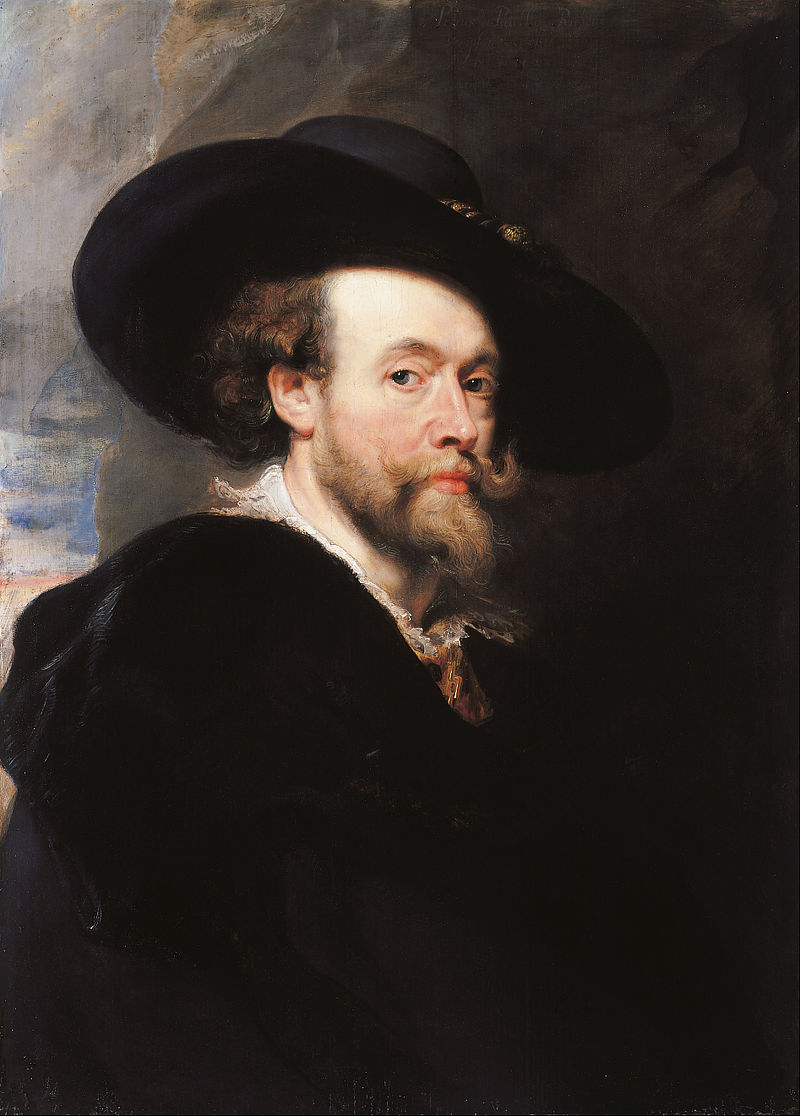
Sir Peter Paul Rubens (/ˈruːbənz/;[1] Dutch: [ˈrybə(n)s]; 28 June 1577 – 30 May 1640) was a Flemish artist. He is considered the most influential artist of Flemish Baroque tradition. Rubens’ highly charged compositions reference erudite aspects of classical and Christian history. His unique and immensely popular Baroque style emphasized movement, color, and sensuality, which followed the immediate, dramatic artistic style promoted in the Counter-Reformation. Rubens specialized in making altarpieces, portraits, landscapes, and history paintings of mythological and allegorical subjects.
In addition to running a large studio in Antwerp that produced paintings popular with nobility and art collectors throughout Europe, Rubens was a classically educated humanist scholar and diplomat who was knighted by both Philip IV of Spain and Charles I of England. Rubens was a prolific artist. The catalogue of his works by Michael Jaffé lists 1,403 pieces, excluding numerous copies made in his workshop.[2]
His commissioned works were mostly “history paintings”, which included religious and mythological subjects, and hunt scenes. He painted portraits, especially of friends, and self-portraits, and in later life painted several landscapes. Rubens designed tapestries and prints, as well as his own house. He also oversaw the ephemeral decorations of the royal entry into Antwerp by the Cardinal-Infante Ferdinand of Austria in 1635.
His drawings are predominantly very forceful and without great detail. He also made great use of oil sketches as preparatory studies. He was one of the last major artists to make consistent use of wooden panels as a support medium, even for very large works, but he used canvas as well, especially when the work needed to be sent a long distance. For altarpieces he sometimes painted on slate to reduce reflection problems.
Source: Peter Paul Rubens – Wikipedia
Salvator Mundi (Leonardo)
Salvator Mundi is a painting of Christ as Salvator Mundi (Latin for “Savior of the World”) by Italian artist Leonardo da Vinci, dated to c. 1500. The painting shows Jesus, in Renaissance dress, giving a benediction with his right hand raised and two fingers extended, while holding a transparent rock crystal orb in his left hand, signaling his role as savior of the world and master of the cosmos, and representing the ‘crystalline sphere’ of the heavens, as it was perceived during the Renaissance.[1][2] Aroun
La belle ferronnière
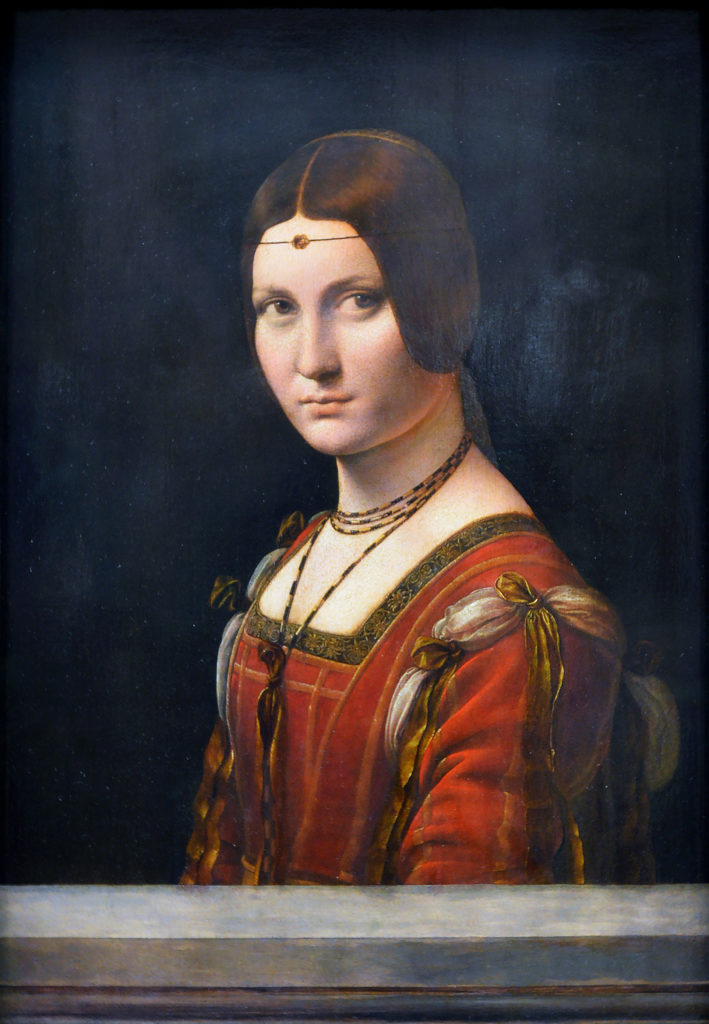
La belle ferronnière is a portrait of a lady, usually attributed to Leonardo da Vinci, in the Louvre. It is also known as Portrait of an Unknown Woman. The painting’s title, applied as early as the seventeenth century, identifying the sitter as the wife or daughter of an ironmonger (a ferronnier), was said to be discreetly alluding to a reputed mistress of Francis I of France, married to a certain Le Ferron. The tale is a romantic legend of revenge in which the aggrieved husband intentionally infects himself with syphilis, which he passes to the king through infecting his wife.[citation needed]
Leonardo’s Lady with an Ermine, has also been known by this name. This was once believed to be a portrait of Cecilia Gallerani—one of the mistresses of Lodovico ‘il Moro’ Sforza, Duke of Milan.[1] The narrative and the title were applied to Lady with an Ermine when it was in Princess Czartoryski’s collection, and became confused with La Belle Ferronniere by the presence in this image also of a jewel worn on a delicate chain across the forehead, called a ferronnière.
Source: La belle ferronnière – Wikipedia
Lady with an Ermine
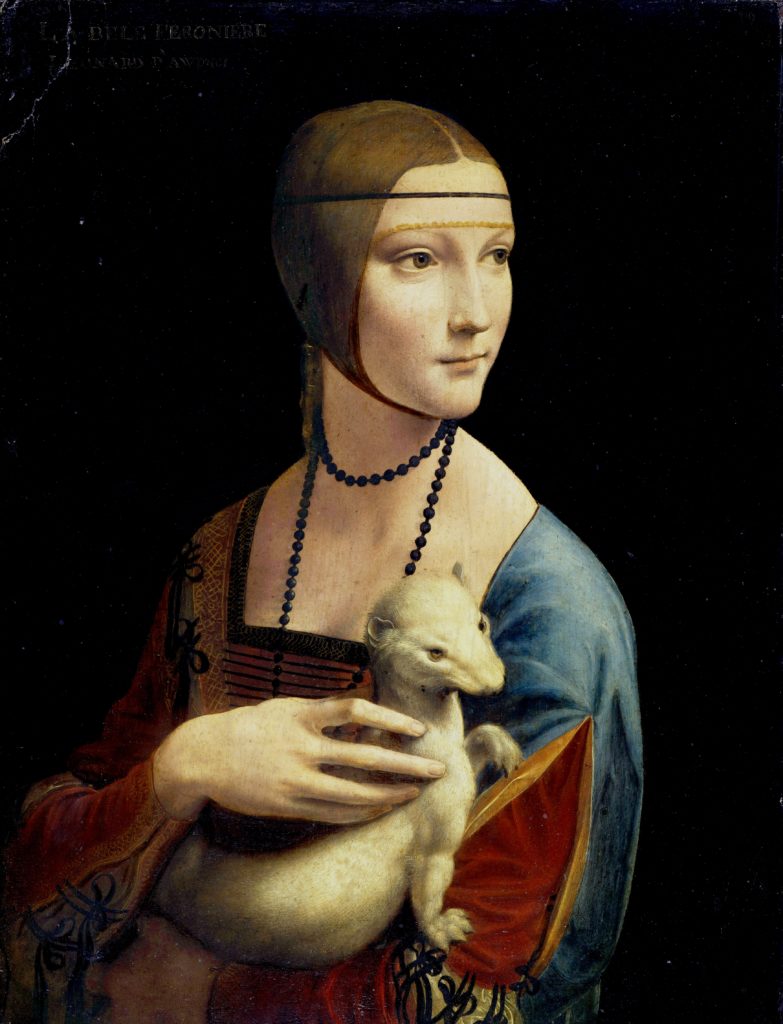
Lady with an Ermine (Italian: Dama con l’ermellino [ˈdaːma kon lermelˈliːno]; Polish: Dama z gronostajem) is a painting by Italian artist Leonardo da Vinci from around 1489–1490 and one of Poland’s national treasures.[2] The portrait’s subject is Cecilia Gallerani, painted at a time when she was the mistress of Ludovico Sforza, Duke of Milan, and Leonardo was in the Duke’s service. It is one of only four portraits of women painted by Leonardo, the others being the Mona Lisa, the portrait of Ginevra de’ Benci, and La belle ferronnière. The painting was purchased in 2016 from the Czartoryski Foundation by the Polish Ministry of Culture and National Heritage for the National Museum in Kraków, and has been on display in the museum’s main building since 2017.[3] Source: Lady with an Ermine – Wikipedia
